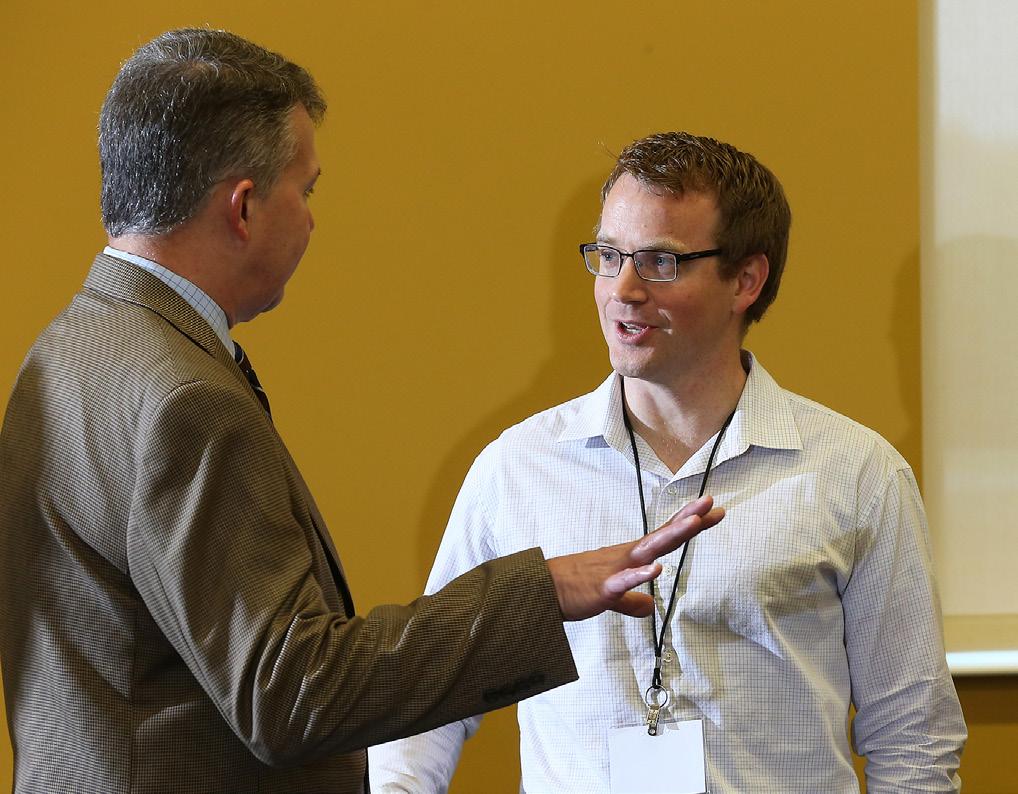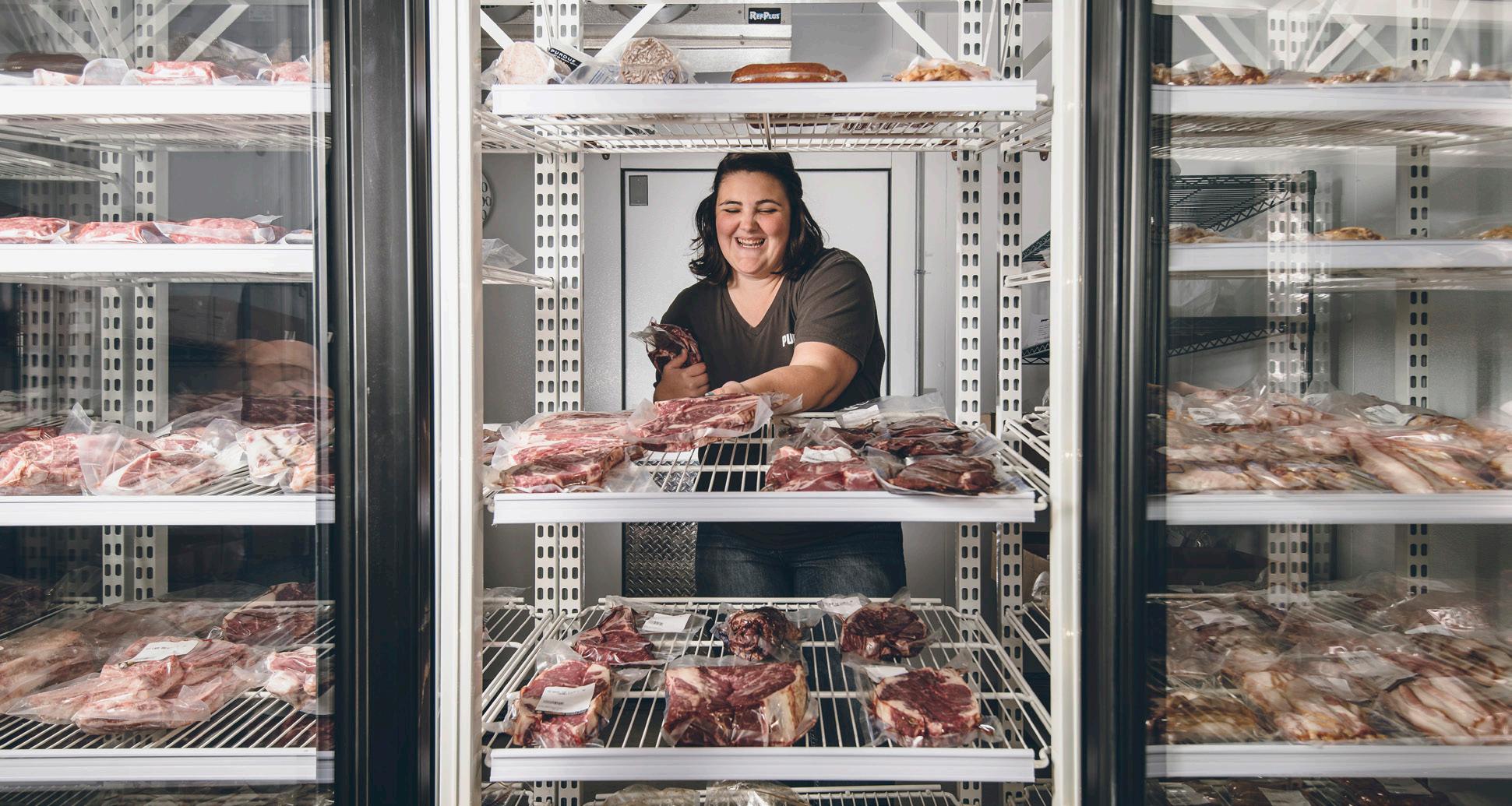
6 minute read
FACULTY FOCUS
environmental factors.) By understanding the genetic basis underlying the phenotypic variability in such traits as response to heat stress, temperament, food allergy response and certain diseases, he can help producers breed more resilient animals. Animals that are less stressed live longer, produce more or grow faster, and have fewer health problems, Brito notes. His work focuses primarily on beef cattle, dairy cattle and swine. But another component of his research involves improving the performance of the so-called minor species in smallholder production systems and developing countries — “minor” not for their importance but because they are less studied, he notes. Such animals include sheep and goats, ducks, alpacas and buffalo. LUIZ BRITO PURDUE UNIVERSITY During his PhDprogram at the University of Guelph (Canada), Luiz Brito spent a year in New Zealand developing genetic tools to improve meat quality in sheep. Last summer, Brito, who joined the animal sciences faculty at Purdue in August 2018 as assistant professor of quantitative genetics and genomics, attended an international conference where sheep breeding companies showed the substantial genetic progress they had achieved in a short time using the methods that he helped to develop. The researcher was thrilled to see his work bridging science and application. “We are working for the foodproducing sector,” he says. “One of the ways to feed a growing population is to improve the productive efficiency of our animals. We are developing research that will have applicability to farmers and enable them to produce better quality food in the face of climate change conditions, with exemplary welfare for animals and lower prices for consumers.” Toward these objectives, Brito’s lab at Purdue uses quantitative genetics, genomics and systems biology to genetically improve livestock species. “Our primary goal is to enhance animal welfare and behavior and adaptation to challenging environments by integrating their genomic information combined with largescale phenotyping,” he explains. (Phenotype refers to physical traits influenced by both genetic code and Brito became interested in genetics while growing up on a livestock breeding farm in Brazil. He recalls being fascinated by the idea of crossing guineafowls and being able to predict the color of the progeny. As a university student, “I learned that with genetics we can make progress that’s permanent and cumulative over generations, which is very rewarding,” he says. Brito received a 2020 seed grant from AgSEED (Agricultural Science and Extension for Economic Development), the college’s competitive internal grant program. He, ANSC dairy specialist Jackie Boerman, and their USDA collaborators are using data from one of the world’s largest precision dairy farms, in Plymouth, Indiana, to envision a “precision genomic index” that could assess animal welfare, behavior, health and productive efficiency, as well as to genetically identify and breed cows that are more suitable to precision dairy farming conditions. AgSEED funding “provides us with the opportunity to give back to the Indiana community by doing research directly applicable to Indiana dairy producers,” he says. “It enables researchers to try projects in cutting-edge areas. “We can look if there is potential and collect data so we can apply for larger, federal grants.” The first-time faculty member says the department provides the infrastructure and support he needs to be successful. From his lab, he’s keeping his eye on applicability and outreach. “I want to show the producers and general public that genetics and genomics aren’t scary,” he adds. “We’re just selecting the best mating animals for the best outcomes. That will have major applications for livestock producers and for the community as a whole.” LUIZ BRITO WORKS TO BRIDGE SCIENCE AND APPLICATION 14

Advertisement
TIM JOHNSON 15 COLLEGE OF AGRICULTURE TIM JOHNSON EXPLORES THE ANIMAL MICROBIOME Tim Johnson,assistant professor of animal sciences, is part of a team developing a sensor that could rapidly tell producers not only which of their beef cattle or dairy cows have bovine respiratory disease (BRD), but also the antibiotic to most effectively treat it. At the core of the project is Johnson’s research on animal microbiomes — the complex community of microbes that inhabit a single environment, like a livestock animal’s respiratory tract. Through a Purdue-sponsored program that supports collaboration among researchers across agriculture and engineering, Johnson teamed up with Mohit Verma, assistant professor of agricultural and biological engineering, and senior research engineer Aaron Ault. Initially supported with a Purdue seed grant, their partnership won a larger USDA grant and support from major producers that is enabling Johnson to study the respiratory microbiome in cattle across the country. Members of the team, Jackie Boerman, assistant professor of animal sciences, and Jon Schoonmaker, associate professor of animal sciences, will go to large farms in California, Texas, Florida, New York and Indiana; establish relationship with farmers in each area; and collect nasal samples from 200 healthy and sick dairy cows and beef cattle in each region. “This project is a win-win for me as a researcher and for the industry,” Johnson says. “It’s both a description of the antibiotic resistance problem and a solution to it.” Johnson’s team will develop bioassays to determine the antibiotic resistance of BRD pathogens as well as characterizing the nasal microbiome in sick and healthy animals. Johnson’s Animal Microbiome Laboratory at Purdue conducts research to improve nutrition and health in cattle, swine and poultry. The work relies extensively on DNA sequencing. By combining newer genetic sequencing and established quantitative processes, Johnson studies the genes of the pathogens themselves to determine what makes animals more susceptible or resistant. BRD is the costliest disease in cattle, requiring antibiotic treatment based on a combination of past experience and a best guess. This approach is often unsuccessful, because producers have to treat sick animals multiple times, while the pathogens simultaneously become more resistant and the antibiotics less effective. With the new sensor, “our goal is to give producers more information in the amount of time they need it so they’re able to effectively treat their animals with a positive outcome the first time,” Johnson says. Doing so decreases the use of antibiotics, which should lead to animals having less antibiotic-resistant bacteria, he adds. That in turn means savings for farmers, safer manure, reduced environmental impact and improved animal welfare — “all the benefits that come along with animals being healthy.” Since coming to Purdue in August 2017, Johnson has tapped several university programs to position his lab as a resource in this changing environment. One is the College of Agriculture’s competitive internal grant program, AgSEED (Agricultural Science and Extension for Economic Development). “Say you’ve got this idea that you’re really interested in,” he says, acknowledging that researchers’ ideas usually outpace their time or money. “You need the freedom to start working on it, and to challenge your students to start working on the problem. You need to have some indication that your project is going to be successful before a larger funder is going to give you the time of day.” So far, the approach is working. Johnson also credits his animal sciences colleagues for their support in his first faculty position. “I think the department is focused on developing solutions to animal producers’ problems and eager to incorporate microbiome research into their research programs,” he says. “And they’re looking to help junior faculty to have successful careers.”







